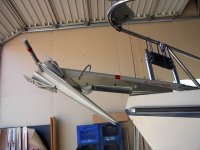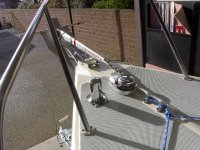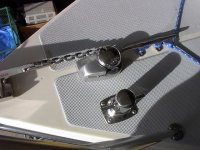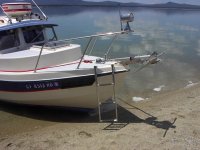Our 2006 22' came with a damaged anchor roller installed. It was quite small (maybe a Sundog brand?) the body was bent and the wheel was mangled. I ended up ordering a Lewmar fixed anchor roller (http://www.lewmar.com/products.asp?id=8361&lid=25869) from Defender to replace the old one.
The Lewmar is bigger and stronger, and the hole pattern is obviously different. I'm trying to figure out how to position it (how much to overhang) and there is no manual to consult. I want to have it far enough out that the Delta 14# doesn't hit the hull when launching or retrieving, but I also don't want to have it hang out far enough that it over-stresses the cored deck structure. When I do the install, I will fill the old holes and drill/dremel/epoxy/redrill the new ones.
I also ended up making an offer on a used Lewmar pivoting roller (http://www.lewmar.com/products.asp?id=8361&lid=25868) on ebay and getting it for $50. Once I have them both in hand I'll pick one to install and sell the other on ebay.
Any suggestions, rules of thumb, etc. on placing either type of roller? If you have either one of these rollers, would you mind measuring from the tip of the bow to the foremost bolt?
Also, would it make sense to try and make a backing plate instead of using fender washers? Or are large fender washers enough?
Thanks in advance for your input!
The Lewmar is bigger and stronger, and the hole pattern is obviously different. I'm trying to figure out how to position it (how much to overhang) and there is no manual to consult. I want to have it far enough out that the Delta 14# doesn't hit the hull when launching or retrieving, but I also don't want to have it hang out far enough that it over-stresses the cored deck structure. When I do the install, I will fill the old holes and drill/dremel/epoxy/redrill the new ones.
I also ended up making an offer on a used Lewmar pivoting roller (http://www.lewmar.com/products.asp?id=8361&lid=25868) on ebay and getting it for $50. Once I have them both in hand I'll pick one to install and sell the other on ebay.
Any suggestions, rules of thumb, etc. on placing either type of roller? If you have either one of these rollers, would you mind measuring from the tip of the bow to the foremost bolt?
Also, would it make sense to try and make a backing plate instead of using fender washers? Or are large fender washers enough?
Thanks in advance for your input!




